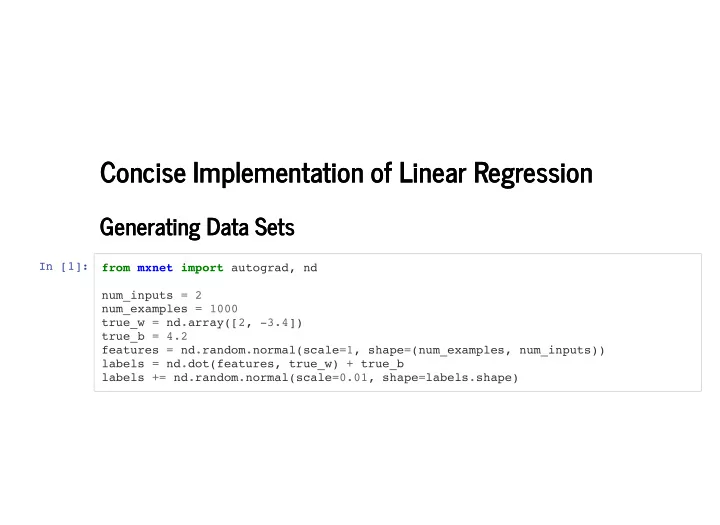

Concise Implementation of Linear Regression Concise Implementation of Linear Regression Generating Data Sets Generating Data Sets In [1]: from mxnet import autograd, nd num_inputs = 2 num_examples = 1000 true_w = nd.array([2, -3.4]) true_b = 4.2 features = nd.random.normal(scale=1, shape=(num_examples, num_inputs)) labels = nd.dot(features, true_w) + true_b labels += nd.random.normal(scale=0.01, shape=labels.shape)
Reading Data Reading Data In [2]: from mxnet.gluon import data as gdata batch_size = 10 # Combine the features and labels of the training data dataset = gdata.ArrayDataset(features, labels) # Randomly reading mini-batches data_iter = gdata.DataLoader(dataset, batch_size, shuffle= True )
Read a Data Batch Read a Data Batch In [3]: for X, y in data_iter: print(X, y) break [[ 0.91097313 -1.1046128 ] [-0.23816614 -0.3334923 ] [-2.7786708 0.01066511] [ 0.05081175 -0.55327344] [-1.3000388 1.5999995 ] [-0.02302935 1.7881038 ] [-1.0592172 -0.47244707] [-1.4682877 0.5651783 ] [-0.70997626 -1.0089529 ] [ 1.1747298 1.1240152 ]] <NDArray 10x2 @cpu(0)> [ 9.7651005 4.8740754 -1.3962101 6.187774 -3.8292062 -1.9272817 3.681892 -0.6382029 6.213706 2.720426 ] <NDArray 10 @cpu(0)>
De�ne the Model De�ne the Model In [4]: from mxnet.gluon import nn net = nn.Sequential() net.add(nn.Dense(1))
Initialize Model Parameters Initialize Model Parameters Initialize weight parameter by a normal distribution with a mean of 0 and standard deviation of 0.01. The bias parameter is initialized to zero by default. In [5]: from mxnet import init net.initialize(init.Normal(sigma=0.01))
De�ne the Loss Function De�ne the Loss Function In [6]: from mxnet.gluon import loss as gloss loss = gloss.L2Loss() # The squared loss is also known as the L2 norm loss
De�ne the Optimization Algorithm De�ne the Optimization Algorithm In [7]: from mxnet import gluon trainer = gluon.Trainer(net.collect_params(), 'sgd', {'learning_rate': 0.03})
Training Training In [8]: num_epochs = 3 for epoch in range(1, num_epochs + 1): for X, y in data_iter: with autograd.record(): l = loss(net(X), y) l.backward() trainer.step(batch_size) l = loss(net(features), labels) print('epoch %d , loss: %f ' % (epoch, l.mean().asnumpy())) epoch 1, loss: 0.035035 epoch 2, loss: 0.000130 epoch 3, loss: 0.000049
Evaluate Evaluate In [9]: w = net[0].weight.data() print('Error in estimating w', true_w.reshape(w.shape) - w) b = net[0].bias.data() print('Error in estimating b', true_b - b) Error in estimating w [[ 0.00043857 -0.00051284]] <NDArray 1x2 @cpu(0)> Error in estimating b [-4.1007996e-05] <NDArray 1 @cpu(0)>
Recommend
More recommend